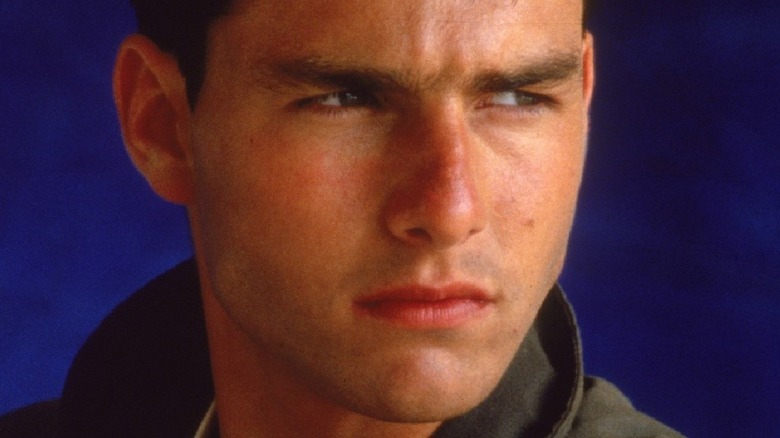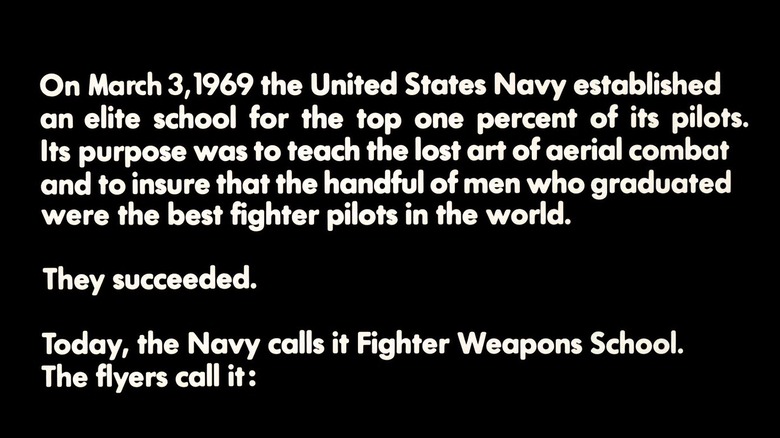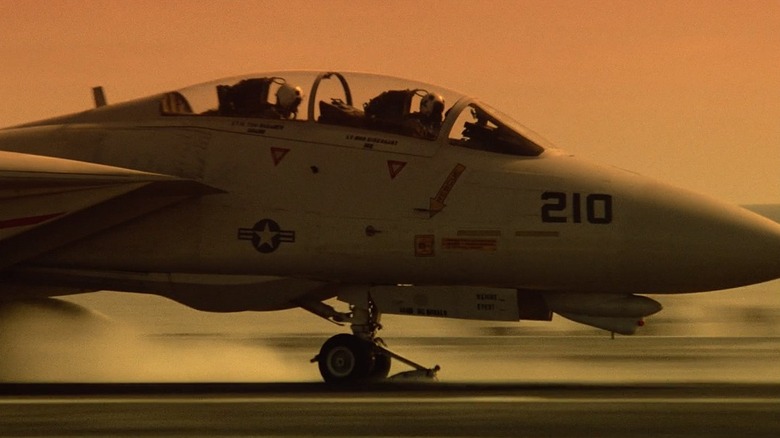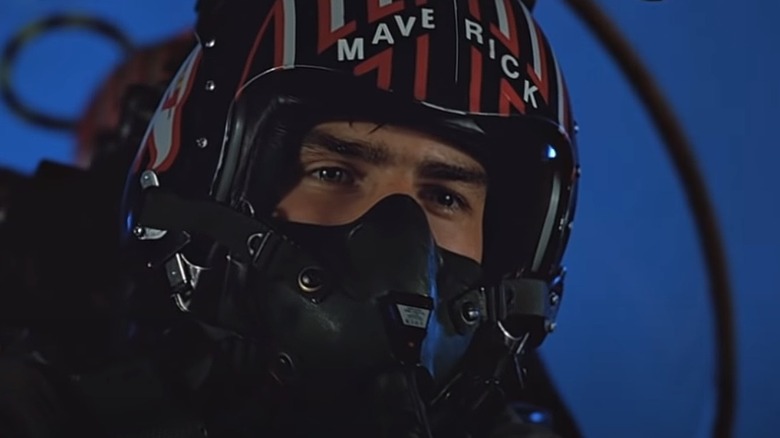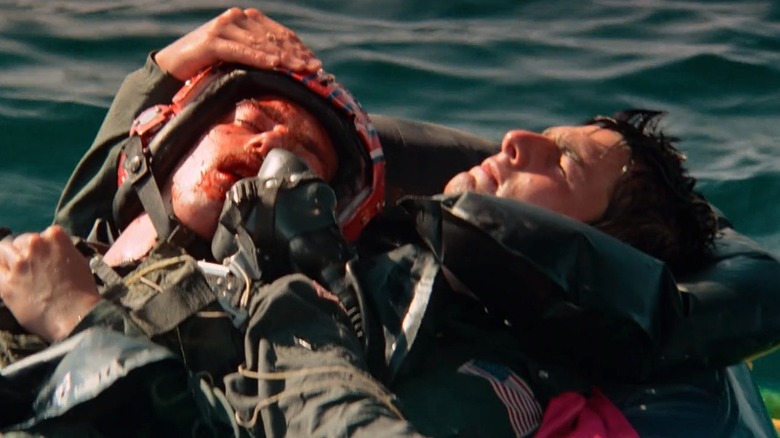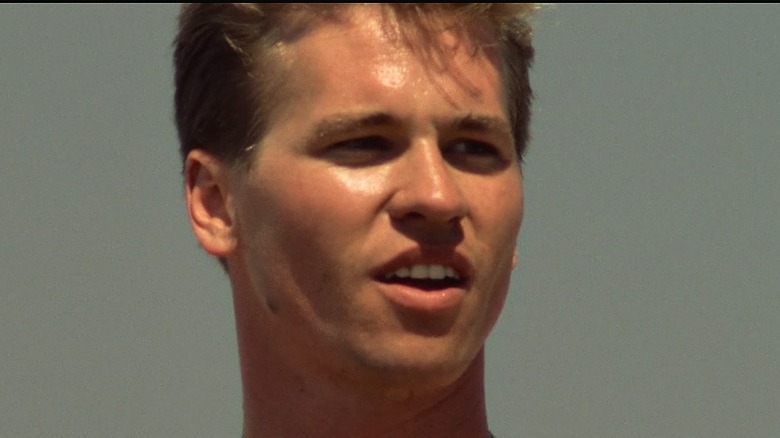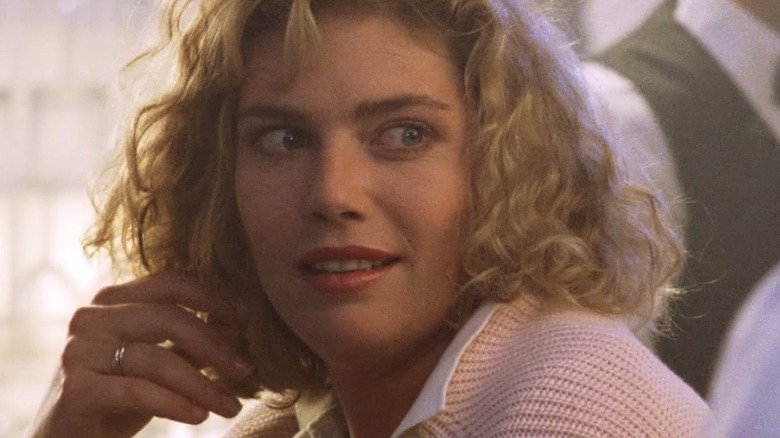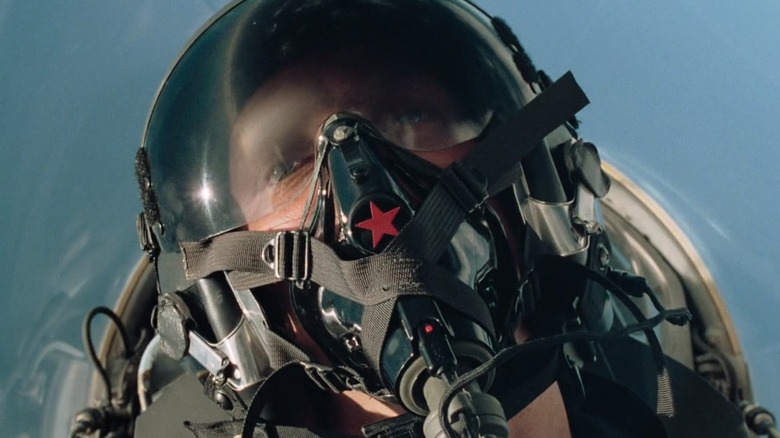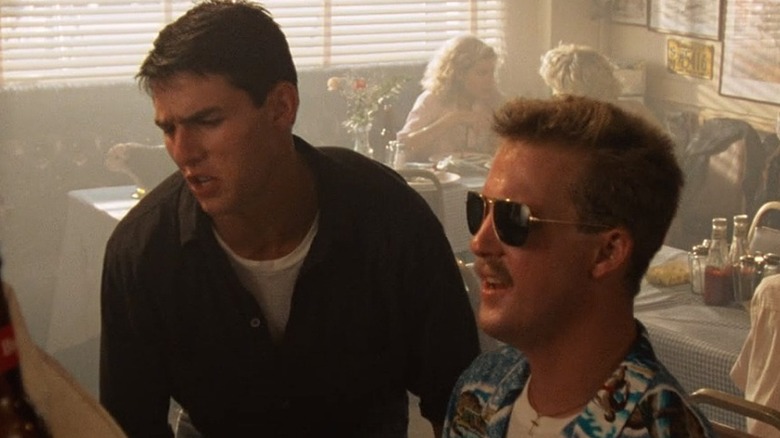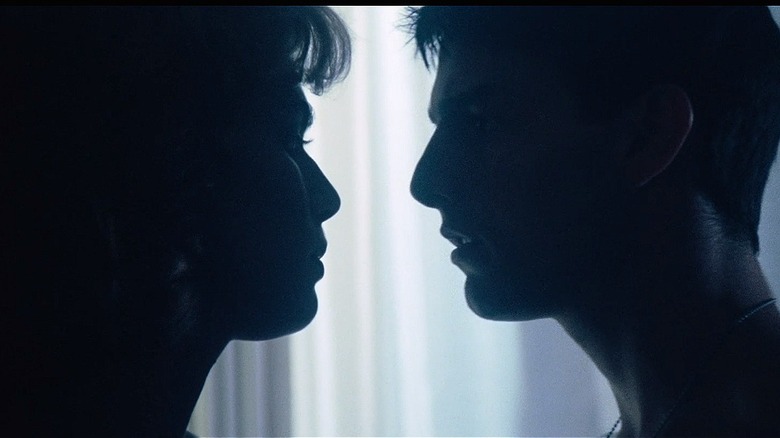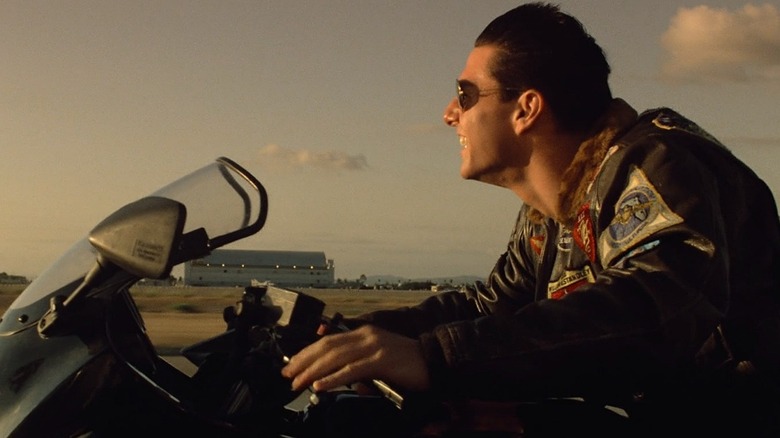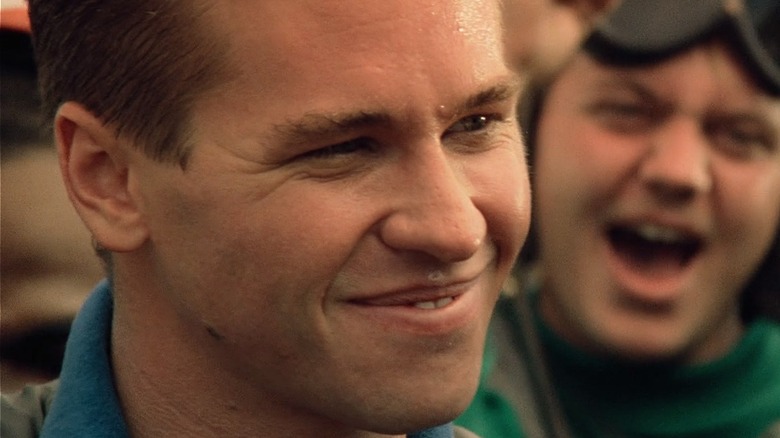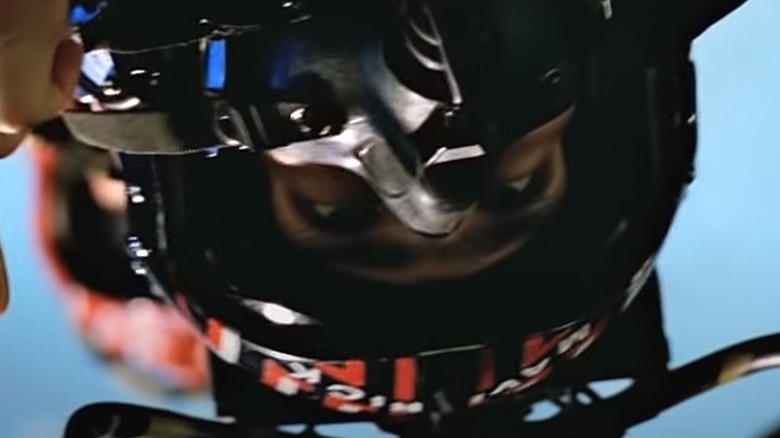The Most Pause-Worthy Moments In Top Gun
When it comes to blockbuster movies from the 1980s, "Top Gun" stands out above the rest for its high-flying action and star-studded cast. The film takes place at the United States Navy's Fighter Weapons School, known as TOPGUN, and revolves around the nation's most elite pilots. With an even more successful sequel having just been released, it's the perfect time to dive back into what made the first 1986 film so memorable.
The original "Top Gun" was directed by Tony Scott and featured an impressive cast with actors like Tom Cruise, Val Kilmer, Kelly McGillis, and Anthony Edwards in standout roles. Cruise plays Lt. Pete "Maverick" Mitchell, a hotheaded but skilled pilot who often pushes the limits of his plane and the rules. Kelly McGillis plays Charlie Blackwood, a TOPGUN instructor who begins a romantic relationship with Maverick. Val Kilmer and Anthony Edwards play Tom "Iceman" Kazansky and Nick "Goose" Bradshaw, two other pilots who develop a competitive rivalry and brotherly friendship with Maverick respectively.
To fans of "Top Gun," the movie has earned its place in pop culture by offering audiences iconic imagery, a catchy soundtrack, dazzling jet fighter action, and plenty of beach volleyball. While critics didn't regard the film highly when it was released, it ended up being a massive box office success with a total worldwide gross of more than $350 million. The movie has numerous scenes that require extra attention for how exciting, interesting, strange, and over-the-top they are, so here are the most pause-worthy moments in "Top Gun."
The prologue
Before launching into any Mach-2 dogfighting or piano singalongs, both "Top Gun" and its sequel "Top Gun: Maverick" open with white text over a black screen in order to give audiences some essential background information. The prologue explains that on March 3rd, 1969, the U.S. Navy established an elite school for fighter pilots who displayed extraordinary talents. By only allowing in the top 1% of candidates, the school became renowned for teaching the "lost art of aerial combat" to a new generation.
The text ends with a fittingly tongue-in-cheek statement that the school goes by a different name to the flyers who attend it, before flashing to the main title: "Top Gun." This moment perfectly sets the stage for the film by helping viewers understand what kind of environment the story will unfold within, as well as what sort of hotshot pilots will be introduced at this school.
Although the opening neglects to mention that the film is heavily fictionalized from a magazine article a few years earlier, the existence of the Fighter Weapons School is still completely based on reality. Becoming a real TOPGUN pilot is extremely difficult: it requires a four-year degree, candidacy acceptance, impeccable physical conditioning, and natural talent. Although part of the reason the U.S. Navy helped support the film's production was to foster recruiting, the odds of any random person actually making it to the Fighter Weapons School is slim.
Danger Zone montage
Opening with a fast-paced montage of jet fighters taking off and landing from the USS Enterprise, set to Kenny Loggins' "Danger Zone," "Top Gun" tries its hardest to grab your attention from the get-go. The filmmakers took a production crew to the real USS Enterprise and, in conjunction with the US Navy, were given permission to record flight deck operations first-hand. It turns out that taking off from an aircraft carrier is extremely dangerous and requires perfect precision from the deck crew. This scene is particularly interesting for how it showcases the skill required to catapult a jet into the air and bring it back on the deck safely. At the same time, it's also a treat to see the little moments of levity and fun the crew deck have during this montage.
Another thing that makes this opening so iconic is the usage of "Danger Zone," a now-famous song that was written specifically for this scene. The story goes that producers Jerry Bruckheimer and Don Simpson were desperate for a song to accompany their footage, and recruited Tom Whitlock and Giorgio Moroder to compose what would become "Danger Zone." Eventually, it was decided that Kenny Loggins would sing the tune since he was already involved with the film's soundtrack, despite not being their first choice for "Danger Zone."
F-14 tower flyby
It becomes clear while watching "Top Gun" that Maverick rarely plays by the rules, especially when his choices are at the expense of his by-the-book superiors. This ethos is perfectly encapsulated during the moment where Maverick and Goose buzz the flight control tower in their F-14, which is a fantasy many real-life fighter pilots have only dreamed of doing but rarely do because of its recklessness. Watching Maverick, and an apprehensive Goose, zoom by Miramar tower and cause their supervisor to spill his coffee all over himself is an early highlight that displays both of their personalities: one leads and the other follows.
In the context of the film, this decision shows just how arrogant and ambitious Maverick really is: he does something extremely over-the-top which gets him into trouble later on. Because of this flyby, both characters are reprimanded by Viper and chastised for their unorthodox behavior. "Top Gun" was a film dedicated to filming real jet fighters actually doing these impressive stunts, something that carried over into the sequel as well. Seeing a real jet buzz a control tower is a unique spectacle that has left many wondering if that kind of stuff actually happens with real fighter pilots.
Goose's death
"Top Gun" isn't all fun and games: there are some serious moments like Goose's death that can tug at the heartstrings and have sparked heated debate over who is to blame. In the film, Goose is Maverick's closest friend as well as his radar operator. The two share the same F-14, with Maverick in the front piloting and Goose in the back feeding him information. During an intense chase scene between Maverick and Iceman over who will claim the TOPGUN trophy, Maverick suffers a flameout of both engines and is forced to eject from the plane. During this ejection Goose is slammed into the detached canopy at high speed, killing him instantly.
Maverick is devastated by the loss of his friend and desperately tries to save him as they wait for rescue in the water below. While he's cleared of any official wrongdoing, Maverick struggles for the rest of the story to cope with this loss. Goose's death is the darkest moment in an otherwise adrenaline-inducing film, and as a result, has become a critical part of the connecting plot between the original movie and its sequel. In "Top Gun: Maverick," the death of his best friend continues to haunt him as Goose's son, Rooster, joins the TOPGUN program himself.
Beach volleyball
If "Top Gun" is known for one thing besides jet fighters, it's shirtless beach volleyball. During a moment of stress relief for the pilots of TOPGUN, several of them go off to play a healthily competitive game of volleyball, with Maverick and Goose squaring off against Iceman and Slider (played by Rick Rossovich). With a large crowd of also shirtless fighter pilots observing the festivities, this scene takes full advantage of the fun being had on set with lots of jumping, high-fiving, diving, and celebrating with each point scored by the TOPGUN recruits.
Set to another Kenny Loggins song, "Playing with the Boys," the volleyball match is given a frantic and exciting pace with lots of quick cuts and match shots made in editing that show each player spiking the ball in succession. Maverick, Goose, Iceman, and Slider all do their fair share of showmanship and boasting while playing, such as Slider howling into the air like a madman. The "Top Gun" volleyball scene has been parodied in shows like "American Dad!" because of how fun, ridiculous, and over-the-top it is. Not only is this an enjoyably low-stakes part of the movie, but it also reinforces the rivalry between Maverick and Iceman through their desire to beat each other on the ground as well as in the skies. Their back and forth banter, combined with taunts, makes this game of volleyball a fan-favorite scene in "Top Gun," especially because of its reputation for awakening many people's sexuality thanks to all the shirtless action.
The sing-along in the bar
As an early introduction to the movie's principal characters, the bar sing-along establishes what Maverick, Goose, and Charlie are like when they're off-duty, while also framing Iceman and Slider as antagonists. At a nearby bar off-base, Maverick and Goose decide their best course of action is to try and hit on random women. Maverick quickly becomes enamored with Charlie, who he doesn't yet realize will be his instructor, and recruits Goose to help him sing her a song. The song of choice for these two hotshots is none other than "You've Lost That Lovin' Feelin'" by The Righteous Brothers, which they somehow get even more pilots to support as background vocalists.
"You've Lost That Lovin' Feelin'" is called back towards the end of the film when Charlie plays it on the jukebox to get Maverick's attention, but this first appearance is strange enough to make it pause-worthy. What becomes clear is that this isn't the first time Maverick and Goose have done this surprisingly well-choreographed routine, since they execute the moves flawlessly. It doesn't take a fighter pilot to realize that this bizarre sing-along scene has not aged as well as other parts of this movie, with many openly criticizing Tom Cruise as pretty creepy here.
Maverick taking down bogies
During the finale of "Top Gun," Maverick and Iceman are engaged by a hostile squad of ambiguous origin (although it's widely believed they're supposed to be either North Koreans, Russians, or someone else entirely). Despite being outnumbered, Maverick rejects the idea of abandoning his new wingman and instead regroups with Iceman to blow up four enemy bogeys. Maverick and Iceman successfully manage to survive the high-stakes dogfight through a combination of focus, skill, and teamwork.
For a film with a $15 million dollar budget, it comes as no surprise to find that the aerial combat of "Top Gun" is a special effects highlight that combines real F-14 footage with fake explosions and debris. While directing the feature, Tony Scott ensured that the film would be truly realistic, so they attached cameras to actual Navy planes to record all kinds of aerial stunts that were edited in post. According to a 1986 interview with Time, Paramount allegedly paid upwards of $7,600 an hour to use real pilots for each flight scene, but the results speak for themselves.
Great Balls of Fire
Here's yet another example of Tom Cruise singing, but this time the tune of choice is a piano rendition of Jerry Lee Lewis' classic "Great Balls of Fire." This song is shared between Maverick, Goose, and Goose's son during an intimate moment of friendship between their families. This is also one of few moments that Meg Ryan appears in the story as Goose's wife, Carole Bradshaw. While there is a surprising amount of singing in "Top Gun," it also shows the special relationship between Maverick and Goose. They're close enough that Maverick feels comfortable cuddling beside Carole and singing to their son (who would grow up to become a guy that looks like Miles Teller).
The "Great Balls of Fire" scene is also unique because it takes time to examine the developing romance between Maverick and Charlie, by comparing it with the other couple's very loving and playful relationship. While the boys are off singing their song, Carole makes it clear to Charlie that Maverick is "100-percent, prime-time in love with you." This leads directly into the following scene where Maverick and Charlie make out on top of his motorcycle, so it seems to have worked. Not to mention that this is one of the only times in the movie that there's a reference to Penny, who would become, as played by Jennifer Connelly, Maverick's rekindled love interest in the sequel.
Maverick and Charlie romance
After Maverick spends the entire film's runtime trying to court Charlie, the two finally get together in a dimly-lit lovemaking scene scored with Berlin's "Take My Breath Away," another song written specifically for "Top Gun." The silhouetted kiss of Maverick and Charlie drastically differs from the tone of the rest of the film, making it stand out. The song, which topped the charts upon its release, also brought "Top Gun" some of the only awards buzz it would receive. "Take My Breath Away" was nominated at the 59th Academy Awards for Best Original Song and also at the Golden Globes for the same category that same year. It won both, bringing "Top Gun" two of the only major awards it would receive that season.
Many have criticized the original "Top Gun" for its less-than-realistic love story subplot, filled with strange behavior from Maverick as well as a lack of chemistry between the two leads. But the song was effective in creating enough romance during this scene to strike a chord with audiences around the world, making it enormously popular. "Take My Breath Away" was later covered by pop artist Jessica Simpson in 2004, making the song once again reach the Billboard charts and prolonging the longevity of this unique ballad.
Motorcycle ride
Not only is Maverick an ace pilot, but he's also a speed-racing motorcyclist. Giving him this additional character trait was made in order to complement his need for speed. Apparently, Tom Cruise had never ridden a motorcycle before they shot the film and was given lessons in the parking lot of a shop in El Cajon, California. The motorcycle makes a few appearances in the film, first during the tail end of the "Danger Zone" montage as Maverick rides alongside the runway of Miramar Marine Corps Air Station.
In his leather bomber and aviator sunglasses, Maverick cheers to a nearby jet fighter taking off as he rides beside it at a fast pace in a moment of high-speed levity. Later on in the film, the motorcycle is shared between Maverick and Charlie as they romantically ride around the docks at night. In the first "Top Gun," Maverick rides a specially decorated Kawasaki GPZ900R, which was one of the fastest motorcycles around at the time the film was made. This cycle had a top speed of around 155 mph. That's both extremely fast and extremely dangerous to reach without wearing a helmet, as Tom Cruise does, but he's not one to fear dangerous stunts.
Iceman handshake
The adversarial rivalry between Maverick and Iceman was an essential part of the narrative of "Top Gun," so it is very satisfying for many fans to see their relationship grow into one of begrudging respect. After Maverick refuses to abandon Iceman, who's his wingman, the two land on the USS Enterprise and happily shake each other's hands for the first time. The moment is met with excited yelling, cheering, and applause from the deck crew around them.
Val Kilmer, who plays Iceman, has had throat cancer since 2017, which has sadly taken his voice away. His place within the "Top Gun" franchise was something the filmmakers of "Top Gun: Maverick" took into account, expanding on Iceman by incorporating the actor's real-life experiences into the character. His appearance in both films is much more impactful for audiences today, with the knowledge that Kilmer has gone through the same things in his own life that the character of Iceman deals with in "Top Gun: Maverick."
Upside-down flick-off
In a movie full of wild jet fighting and impressive mid-air stunts, Maverick going upside down above an enemy jet to give them a middle finger might take the cake. In the scene, Maverick is sent to intercept an enemy fighter who begins engaging his F-14. He's instructed not to fire upon the MiG until fired upon first, so instead, he taunts the other aircraft. In a way that only Maverick could achieve, he flies above them upside down, flicks them off, and then takes a picture with a flash camera which he somehow all does within a few seconds.
While this is undeniably cool-looking, many fans often wonder if something like this is even possible, with people arguing about the logistics of whether even a pilot as skilled as Maverick could make it happen without crashing into the other planes. Regardless of how realistic it is, the scene has proven to be one of the more memorable escapades Maverick does in the movie. Some real-life fighter pilots have even recreated the scene themselves, albeit with much more advanced hardware.
